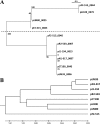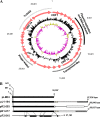Mosaic-like sequences containing transposon, phage, and plasmid elements among Listeria monocytogenes plasmids
- PMID: 20511420
- PMCID: PMC2901719
- DOI: 10.1128/AEM.02799-09
Mosaic-like sequences containing transposon, phage, and plasmid elements among Listeria monocytogenes plasmids
Abstract
Sequencing of plasmid pLM33 from the food isolate Listeria monocytogenes Lm1 revealed a molecule of 32,307 bp with a G+C content of 36.2%. The plasmid displays a mosaic pattern of identities common to several closely related L. monocytogenes plasmids isolated from food and clinical sources.
Figures



Similar articles
-
Plasmid-borne cadmium resistance genes in Listeria monocytogenes are present on Tn5422, a novel transposon closely related to Tn917.J Bacteriol. 1994 May;176(10):3049-61. doi: 10.1128/jb.176.10.3049-3061.1994. J Bacteriol. 1994. PMID: 8188606 Free PMC article.
-
R391: a conjugative integrating mosaic comprised of phage, plasmid, and transposon elements.J Bacteriol. 2002 Sep;184(18):5158-69. doi: 10.1128/JB.184.18.5158-5169.2002. J Bacteriol. 2002. PMID: 12193633 Free PMC article.
-
Conjugative mobilization of the rolling-circle plasmid pIP823 from Listeria monocytogenes BM4293 among gram-positive and gram-negative bacteria.J Bacteriol. 1999 Jun;181(11):3368-74. doi: 10.1128/JB.181.11.3368-3374.1999. J Bacteriol. 1999. PMID: 10348847 Free PMC article.
-
pLM33 provides tolerance of persistent Listeria monocytogenes ST5 to various stress conditions and also enhances its virulence.Food Microbiol. 2025 Mar;126:104675. doi: 10.1016/j.fm.2024.104675. Epub 2024 Oct 28. Food Microbiol. 2025. PMID: 39638448
-
Comparison of the genome sequences of Listeria monocytogenes and Listeria innocua: clues for evolution and pathogenicity.FEMS Immunol Med Microbiol. 2003 Apr 1;35(3):207-13. doi: 10.1016/S0928-8244(02)00448-0. FEMS Immunol Med Microbiol. 2003. PMID: 12648839 Review.
Cited by
-
A Large-Scale Sequencing-Based Survey of Plasmids in Listeria monocytogenes Reveals Global Dissemination of Plasmids.Front Microbiol. 2021 Mar 12;12:653155. doi: 10.3389/fmicb.2021.653155. eCollection 2021. Front Microbiol. 2021. PMID: 33776982 Free PMC article.
-
Genomic Characterization of Livestock-Associated Methicillin-Resistant Staphylococcus aureus ST7 Isolates from a Case of Human Bacteremia in China.Infect Drug Resist. 2022 Dec 15;15:7449-7457. doi: 10.2147/IDR.S385061. eCollection 2022. Infect Drug Resist. 2022. PMID: 36544989 Free PMC article.
-
ON-rep-seq as a rapid and cost-effective alternative to whole-genome sequencing for species-level identification and strain-level discrimination of Listeria monocytogenes contamination in a salmon processing plant.Microbiologyopen. 2021 Nov;10(6):e1246. doi: 10.1002/mbo3.1246. Microbiologyopen. 2021. PMID: 34964295 Free PMC article.
-
Hypo- and Hyper-Virulent Listeria monocytogenes Clones Persisting in Two Different Food Processing Plants of Central Italy.Microorganisms. 2021 Feb 13;9(2):376. doi: 10.3390/microorganisms9020376. Microorganisms. 2021. PMID: 33668440 Free PMC article.
-
Conservation and distribution of the benzalkonium chloride resistance cassette bcrABC in Listeria monocytogenes.Appl Environ Microbiol. 2013 Oct;79(19):6067-74. doi: 10.1128/AEM.01751-13. Epub 2013 Jul 26. Appl Environ Microbiol. 2013. PMID: 23892748 Free PMC article.
References
-
- Altschul, S. F., W. Gish, W. Miller, E. W. Myers, and D. J. Lipman. 1990. Basic local alignment search tool. J. Mol. Biol. 215:403-410. - PubMed
-
- Cossart, P., and A. Toledo-Arana. 2008. Listeria monocytogenes, a unique model in infection biology: an overview. Microbes Infect. 10:1041-1050. - PubMed
-
- Francis, M. S., and C. J. Thomas. 1997. The Listeria monocytogenes gene ctpA encodes a putative P-type ATPase involved in copper transport. Mol. Gen. Genet. 253:484-491. - PubMed
-
- Glaser, P., L. Frangeul, C. Buchrieser, C. Rusniok, A. Amend, F. Baquero, P. Berche, H. Bloecker, P. Brandt, T. Chakraborty, A. Charbit, F. Chetouani, E. Couvé, A. de Daruvar, P. Dehoux, E. Domann, G. Domínguez-Bernal, E. Duchaud, L. Durant, O. Dussurget, K. D. Entian, H. Fsihi, F. García-del Portillo, P. Garrido, W. Gautier, W. Goebel, N. Gómez-López, T. Hain, J. Hauf, D. Jackson, L. M. Jones, U. Kaerst, J. Kreft, M. Kuhn, F. Kunst, G. Kurapkat, E. Madueno, A. Maitournam, J. M. Vicente, E. Ng, H. Nedjari, G. Nordsiek, S. Novella, B. de Pablos, J. C. Pérez-Diaz, R. Purcell, B. Remmel, M. Rose, T. Schlueter, N. Simoes, A. Tierrez, J. A. Vázquez-Boland, H. Voss, J. Wehland, and P. Cossart. 2001. Comparative genomics of Listeria species. Science 294:849-852. - PubMed
MeSH terms
Substances
Associated data
- Actions
LinkOut - more resources
Full Text Sources
Molecular Biology Databases

